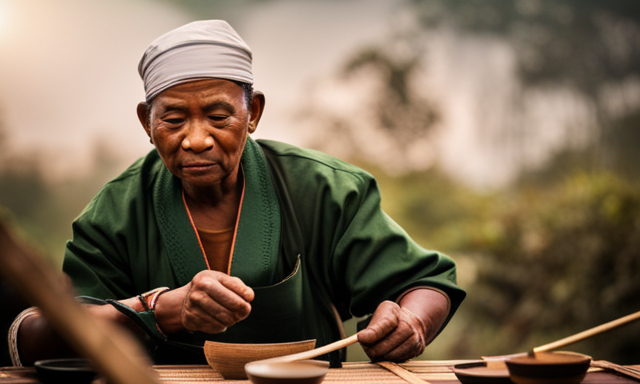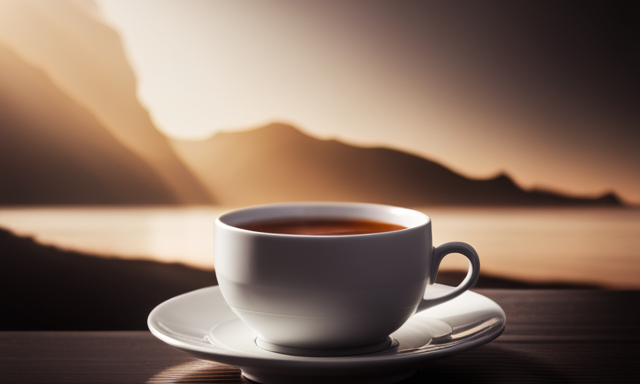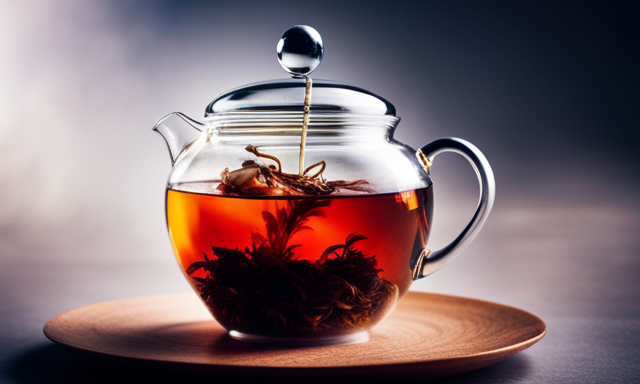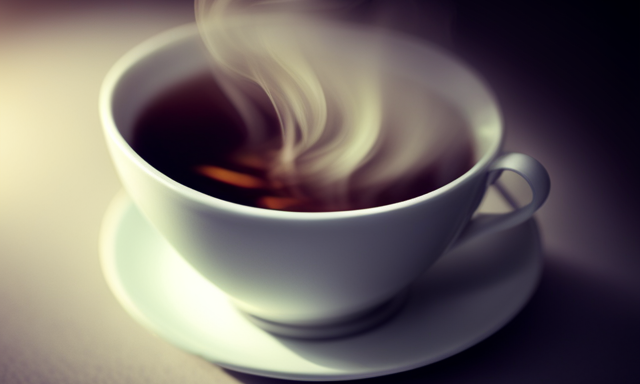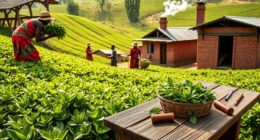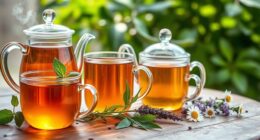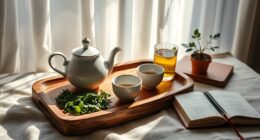Ah, the art of crafting oolong tea. A dance of flavors and aromas that tantalize the senses, leaving you craving for more. Allow me to take you on a journey into the intricate process of how this exquisite tea is made.
From the moment the tea leaves are plucked, to the careful sorting and grading, every step is a testament to the expertise and dedication of the tea artisans.
First, the leaves are plucked with utmost care, ensuring only the finest ones are selected. Then, they undergo a withering process, where they are left to wilt and lose their moisture. This is followed by oxidation, a pivotal step that determines the flavor profile of the tea. The leaves are then fixed to halt the oxidation process before they are skillfully rolled into their distinctive shapes.
As we delve deeper, we will explore the various oolong tea varieties and their unique tasting notes. So, sit back, relax, and prepare to embark on a journey into the world of oolong tea, where craftsmanship meets indulgence.
Key Takeaways
- Oolong tea is made through a series of carefully controlled processes including plucking the finest leaves, withering, controlling temperature and humidity, and fixing the leaves.
- The duration of the withering process and the level of oxidation contribute to the final flavor and aroma of the tea.
- Different methods of fixing, such as pan-frying and roasting, enhance the flavor and depth of the tea.
- The final processing involves steps like rolling the leaves, drying, sorting and grading, and packaging and storage to ensure the tea’s quality and freshness.
Plucking the Tea Leaves
You’ll start by carefully plucking the freshly grown tea leaves from the plant. Gently hold them between your fingers as you admire their vibrant green color and delicate aroma.
Plucking techniques play a crucial role in determining the quality of the leaves. Skilled tea pluckers know how to select the right leaves at the right time, ensuring that only the topmost two leaves and the bud are harvested. This careful selection guarantees that the leaves are at their peak flavor and aroma.
Additionally, plucking by hand allows for a more delicate touch, preventing any damage to the leaves that could affect the final product.
Once the leaves are plucked, they are ready for the next step in the oolong tea-making process: withering. Here, they will undergo controlled drying to develop their unique characteristics.
Withering the Leaves
When it comes to making oolong tea, withering the tea leaves is a crucial step in the process. Allowing the leaves to wilt is an important part of developing the unique flavors and aromas of oolong tea.
Controlling the temperature and humidity during the withering process is essential for achieving the desired results. Additionally, the duration of the withering process must be carefully monitored to ensure that the leaves are neither under-withered nor over-withered.
Allowing the leaves to wilt
Once the leaves have been picked, it is important to let them sit and wilt for a period of time. This wilting process is crucial as it allows the leaves to undergo chemical changes that bring out their distinct characteristics.
As the leaves wilt, enzymes within them break down complex compounds into simpler ones, resulting in the development of new flavors and aromas. Additionally, wilting helps remove excess moisture from the leaves, making them easier to handle during subsequent steps of tea production.
The benefits of withering are numerous, as it contributes to the overall quality and taste of the final product.
Transitioning into the next section about controlling temperature and humidity, it is important to maintain precise conditions to ensure the leaves are properly dried and prepared for further processing.
Controlling temperature and humidity
To achieve the desired flavors and aromas, it’s crucial for me to carefully monitor and regulate the temperature and humidity levels during the tea production process.
Controlling temperature and humidity is of utmost importance as they play a significant role in shaping the final characteristics of oolong tea. The climate in which the tea leaves are withered greatly impacts the overall taste and aroma.
By adjusting the temperature, I can control the rate at which the leaves lose moisture, allowing for the desired level of withering. Additionally, maintaining the appropriate humidity levels ensures that the leaves do not dry out too quickly or retain too much moisture, both of which could negatively affect the quality of the tea.
With the temperature and humidity carefully controlled, I can now move on to the next step, the duration of the withering process.
Duration of withering process
During the withering process, the tea leaves undergo a transformation as they slowly lose moisture and develop the distinct flavors and aromas of fine oolong. The duration of the withering process plays a crucial role in determining the final flavor profile of the tea.
Generally, the longer the withering process, the more complex and robust the flavor becomes. This is because the extended duration allows the tea leaves to undergo more chemical reactions, resulting in the development of rich flavors and aromas.
On the other hand, a shorter withering process may result in a lighter and more delicate flavor. The withering process duration is carefully controlled to strike the perfect balance and create the desired flavor profile for the oolong tea.
As the withering process concludes, the tea leaves are ready to enter the next stage, the oxidation process, where further changes will occur.
Oxidation Process
First, the freshly picked tea leaves are left to wither in the sun, allowing them to naturally begin the oxidation process. Oxidation is a crucial step in the production of oolong tea as it contributes to its unique flavor and aroma. During this process, the leaves are exposed to oxygen, causing chemical reactions that develop the tea’s characteristic taste profile. The duration of oxidation can vary depending on the desired flavor, but generally, it ranges from 20% to 80% oxidation. To better understand the different levels of oxidation and their corresponding flavors, refer to the table below:
| Oxidation Level | Flavor Profile |
|---|---|
| 20% – 30% | Light and floral |
| 40% – 50% | Fruity and sweet |
| 60% – 70% | Rich and toasty |
| 80% | Dark and robust |
By controlling the duration of oxidation, tea producers can achieve a wide range of flavors and aromas in oolong tea. Now, let’s move on to the next step of the process, which involves fixing the leaves…
Fixing the Leaves
When it comes to fixing the leaves in the process of making oolong tea, the oxidation process is halted and heat is applied to the leaves. This step is crucial in order to preserve the desired flavor and aroma of the tea.
There are various methods of fixing the leaves, such as pan-frying or roasting, which contribute to the unique characteristics of different oolong teas.
Halting the oxidation process
To slow down the oxidation process of oolong tea, you can gently interrupt the natural transformation of the tea leaves, helping them retain their delicate flavors and aromas. This step is crucial in controlling oxidation and preserving the unique characteristics of oolong tea.
Once the leaves are fixed, they are spread out in a thin layer and left to wilt. This wilting process allows the leaves to lose some of their moisture, making them more pliable and enhancing the development of their flavors. It is during this time that the leaves undergo chemical changes, resulting in the distinct taste and aroma of oolong tea.
After the wilting stage, the next step involves applying heat to the leaves, which further halts the oxidation process and prepares the leaves for their final processing.
Applying heat to the leaves
Now, you’ll want to carefully apply heat to the leaves, allowing them to undergo a transformative process that enhances their flavors and aromas. Controlling the temperature during this stage is crucial to achieving the desired outcome. There are various tea making techniques used to apply heat to the leaves, including pan-frying and roasting. These methods not only halt the oxidation process but also add depth to the tea’s flavor profile.
To give you a better understanding, here is a table showcasing some common tea making techniques and their corresponding temperature ranges:
| Technique | Temperature Range (°C) |
|---|---|
| Pan-frying | 90-100 |
| Roasting | 120-150 |
| Steaming | 80-90 |
| Baking | 180-200 |
| Charcoal | 200-250 |
By applying heat to the leaves at the appropriate temperature, we can preserve the delicate flavors and aromas while enhancing the overall taste. In the next section, we will explore the different methods of fixing the leaves, such as pan-frying and roasting, to further refine the tea’s characteristics.
Methods of fixing (pan-frying, roasting, etc.)
After applying heat to the leaves, the next step in the process of making oolong tea involves fixing the leaves through various methods such as pan-frying and roasting. These techniques play a crucial role in determining the flavor profile of the final tea.
Pan-frying, also known as ‘kill-green,’ involves quickly heating the leaves in a hot wok or pan. This method helps to halt oxidation and preserve the fresh, grassy flavors of the tea.
On the other hand, roasting involves slowly heating the leaves in a dry environment, which imparts a more robust and smoky taste to the tea.
The choice between pan-frying and roasting depends on the desired flavor profile of the oolong tea. Pan-frying tends to produce lighter and more delicate flavors, while roasting creates deeper and richer notes.
In the subsequent section about rolling the leaves, we will explore how this process further enhances the flavor and aroma of oolong tea.
Rolling the Leaves
First, you’ll need to gently roll the leaves to release their natural flavors and aromas, creating the signature taste of oolong tea. Rolling the leaves is an essential step in the tea-making process as it helps control the moisture content and shape the leaves.
The rolling action breaks down the cell walls of the tea leaves, allowing the essential oils and enzymes to mix and react, resulting in a unique flavor profile. This process also helps to enhance the oxidation process, which is crucial in determining the level of fermentation in oolong tea.
Once the leaves have been rolled, they are ready for the next step of drying, where they are carefully dried to halt oxidation and preserve their flavors.
Drying the Leaves
After the leaves have been carefully rolled, the next step in the process of making oolong tea is drying them. Drying is a crucial step to control the moisture content of the leaves and prevent any further oxidation.
The leaves are spread out in a thin layer on bamboo trays or in large baskets, allowing them to dry naturally. This process can take several hours or even days, depending on the desired level of moisture.
The leaves are often shaken or gently tossed during drying to ensure even moisture distribution. As the leaves dry, their vibrant green color begins to change into the characteristic dark brown hue of oolong tea.
Once the leaves have reached the desired moisture level, they are ready for the next step: sorting and grading.
Now, let’s move on to the fascinating process of sorting and grading oolong tea leaves.
Sorting and Grading
When it comes to sorting and grading oolong tea, the first step is separating the leaves based on their size and quality. This is done to ensure that only the best leaves are used in the final product.
Next, we evaluate the appearance and aroma of the leaves, looking for qualities such as color, shape, and fragrance.
Finally, based on these factors, we are able to determine the tea’s value and its place in the market.
Separating leaves based on size and quality
To create a tantalizing cup of oolong tea, expert tea makers skillfully separate the leaves based on size and quality. This crucial step ensures that only the finest leaves are used in the tea-making process. Here’s how the leaves are sorted:
-
Tea leaf plucking: The leaves used for oolong tea are hand-picked by experienced tea pluckers. They carefully select the leaves that are at the perfect stage of maturity, ensuring optimum flavor and aroma.
-
Tea leaf processing: After plucking, the leaves undergo processing to enhance their flavor and aroma. This includes withering, oxidation, and firing, which give oolong tea its unique characteristics.
-
Quality assessment: Each leaf is meticulously inspected to ensure it meets the highest standards. Leaves with imperfections or inconsistent size are discarded, while the best leaves are retained for further processing.
By separating the leaves based on size and quality, tea makers guarantee that only the finest leaves contribute to the exceptional taste and aroma of oolong tea. This meticulous attention to detail sets the stage for the next step: evaluating appearance and aroma.
Evaluating appearance and aroma
The artful evaluation of appearance and aroma in oolong tea production is akin to a delicate dance between the senses, where each subtle note and captivating hue intertwine to create an enchanting sensory experience. When it comes to evaluating taste and identifying tea quality, experts rely on their expertise and keen senses to discern the nuances that set apart exceptional oolong teas from the ordinary. Examining the appearance of the tea leaves, such as their color, shape, and consistency, provides valuable insights into their quality. Additionally, the aroma of the tea leaves can reveal important information about the tea’s flavor profile and potential. By carefully assessing these factors, tea producers are able to determine the tea’s value and ensure that only the finest oolong teas reach the market. Transitioning into the subsequent section about determining the tea’s value, we delve into the intricacies of assessing the tea’s flavor profile and processing techniques.
Determining the tea’s value
Crafting an enchanting sensory experience, experts rely on their expertise and keen senses to discern the nuances that set apart exceptional oolong teas from the ordinary, determining their value.
When determining marketability, experts consider the taste profiles of different oolong teas. They assess the flavor notes, such as floral, fruity, or nutty, and evaluate the balance, complexity, and mouthfeel of the tea. These factors play a crucial role in determining the tea’s value and desirability in the market.
Additionally, experts consider the overall quality of the tea, including its freshness, color, and clarity. A well-crafted oolong tea with a unique and pleasant taste profile is more likely to fetch a higher price and attract discerning tea enthusiasts.
Transitioning into the subsequent section about packaging and storage, it is essential to ensure that these valuable teas are packaged and stored properly to maintain their freshness and flavor.
Packaging and Storage
Packaging and storage play a crucial role in preserving the flavor and quality of oolong tea. Proper tea storage is essential to prevent the tea leaves from losing their aroma and becoming stale.
To ensure the freshness of oolong tea, it is packaged in airtight containers that protect it from exposure to moisture, light, and air. These packaging techniques help maintain the tea’s flavor and prevent oxidation. The containers are usually made of materials that do not release any odor or chemicals that could affect the tea’s taste.
Additionally, storing oolong tea in a cool and dark place, such as a pantry or a cupboard away from strong odors, helps to preserve its freshness for a longer period.
Now that we have discussed the importance of packaging and storage, let’s move on to the next section about brewing and enjoying oolong tea.
Brewing and Enjoying Oolong Tea
When brewing and enjoying oolong tea, it’s crucial to pay attention to the water temperature and steeping time. This ensures that the delicate flavors and aromas are properly extracted without being overwhelmed or underdeveloped.
Additionally, finding the right tea-to-water ratio is essential for achieving the desired strength and balance of flavors.
Finally, taking the time to appreciate the tea’s unique flavors and aromas enhances the overall experience and allows for a deeper connection with this exquisite beverage.
Water temperature and steeping time
To create the perfect cup of oolong tea, start by heating up your water to the ideal temperature and steeping it for the recommended amount of time. The water temperature and steeping techniques play a crucial role in bringing out the complex flavors and aromas of oolong tea. Too hot of water can result in a bitter taste, while water that is too cool may not extract the full flavor.
To ensure the best results, refer to the following table for the ideal water temperature and steeping time for different types of oolong tea:
| Oolong Tea Type | Water Temperature | Steeping Time |
|---|---|---|
| Light Oolong | 175°F – 190°F | 1 – 2 minutes |
| Medium Oolong | 190°F – 200°F | 2 – 3 minutes |
| Dark Oolong | 200°F – 205°F | 3 – 5 minutes |
By following these guidelines, you’ll be able to extract the perfect balance of flavors from your oolong tea. Now, let’s move on to the next step, which is determining the ideal tea-to-water ratio.
Tea-to-water ratio
To achieve the perfect cup of oolong tea, it’s essential to find the ideal tea-to-water ratio. The recommended brewing technique for oolong tea suggests using 1 teaspoon of loose tea leaves for every 8 ounces of water. This ratio allows the leaves to expand fully and release their flavors, striking a balance between concentration and dilution. Adjusting the amount of tea leaves can impact the strength and intensity of the tea, so it’s crucial to find the right balance according to your preferences. The tea-to-water ratio plays a significant role in bringing out the various flavor profiles of oolong tea, which range from floral and fruity to toasty and nutty. By finding the perfect ratio, you can fully appreciate the tea’s nuances, resulting in a truly enjoyable tea-drinking experience.
Appreciating the tea’s flavors and aromas
Indulging in a cup of oolong tea is like taking a sensory journey through a fragrant garden. Its flavors and aromas transport you to a world of floral and fruity delights. To truly appreciate the exquisite flavors of oolong tea, it’s important to understand and follow proper tea brewing techniques.
The ideal water temperature for brewing oolong tea is around 190-200°F (88-93°C). This temperature allows the leaves to unfurl and release their full flavors. Steeping time can vary depending on personal preference, but generally, 3-5 minutes is recommended.
When it comes to tea pairing suggestions, oolong tea pairs wonderfully with light and delicate foods. Seafood, salads, and fresh fruits are excellent choices. The subtle sweetness and floral notes of oolong tea complement these dishes beautifully.
Now, let’s transition into the subsequent section about oolong tea varieties and tasting notes. We will explore the diverse range of flavors that different oolong teas offer.
Oolong Tea Varieties and Tasting Notes
Sipping on a warm cup of oolong tea transports you to a serene tea garden, where the delicate aroma of orchids and the subtle sweetness of honey intertwine. Oolong tea comes in various varieties, each with its own unique tasting notes. Here are three oolong tea varieties and their corresponding tasting notes:
-
Tie Guan Yin: This oolong tea has a floral aroma and a creamy, buttery flavor. Its tasting notes include hints of orchid, roasted nuts, and a lingering sweetness.
-
Da Hong Pao: Known as the ‘Big Red Robe,’ this oolong tea has a rich, roasted aroma and a complex flavor profile. Its tasting notes include notes of dark chocolate, stone fruit, and a smoky finish.
-
Oriental Beauty: This oolong tea is known for its sweet honey notes and fruity undertones. Its tasting notes include flavors of ripe peaches, honeydew melon, and a hint of muscat grape.
By exploring different oolong tea varieties, you can experience a range of flavors and aromas that make this tea truly special. To fully enjoy these tasting notes, it’s important to brew oolong tea using the proper techniques, such as using water at the right temperature and steeping for the recommended time.
Frequently Asked Questions
How long does it take to pluck the tea leaves for oolong tea?
It typically takes skilled tea pluckers about 2-3 hours to handpick the tea leaves for oolong tea. The plucking process is done efficiently by selecting only the top two leaves and a bud, ensuring high quality flavor.
Can oolong tea be made with any type of tea leaves?
Yes, oolong tea can be made with green tea leaves or black tea leaves. Just like a skilled chef can create different dishes using the same ingredients, tea artisans use different processing techniques to create the unique flavors of oolong tea.
What is the ideal temperature for withering the leaves in the oolong tea-making process?
The ideal withering temperature for oolong tea is around 25-30 degrees Celsius. This temperature allows the tea leaves to undergo enzymatic reactions that result in a unique flavor profile. Higher temperatures can lead to a loss of aroma and astringency.
How does the oxidation process affect the flavor of oolong tea?
The oxidation process plays a crucial role in oolong tea production, affecting its flavor in a fascinating way. By allowing the tea leaves to partially oxidize, the flavor profile of oolong tea becomes complex, with notes ranging from fruity and floral to nutty and toasty.
Is it necessary to roll the leaves during the production of oolong tea, and if so, why?
Yes, it is necessary to roll the leaves during the production of oolong tea. The rolling process plays a crucial role in shaping the flavor and aroma of the tea by releasing natural oils and enzymes from the leaves.
Conclusion
In conclusion, the art of making oolong tea is a meticulous process that requires patience and expertise. The tea leaves are carefully plucked, withered, oxidized, fixed, rolled, sorted, and graded. Each step in this intricate dance contributes to the unique flavor and aroma of oolong tea.
Just as a skilled craftsman, the tea leaves are carefully plucked, withered, oxidized, fixed, rolled, sorted, and graded. Each step in this intricate dance contributes to the unique flavor and aroma of oolong tea.
Sipping a cup of oolong tea is like experiencing a harmonious blend of flavors that dance on your palate, leaving you feeling refreshed and satisfied. It is a symphony of taste that evokes emotions and provides a sense of satisfaction.

